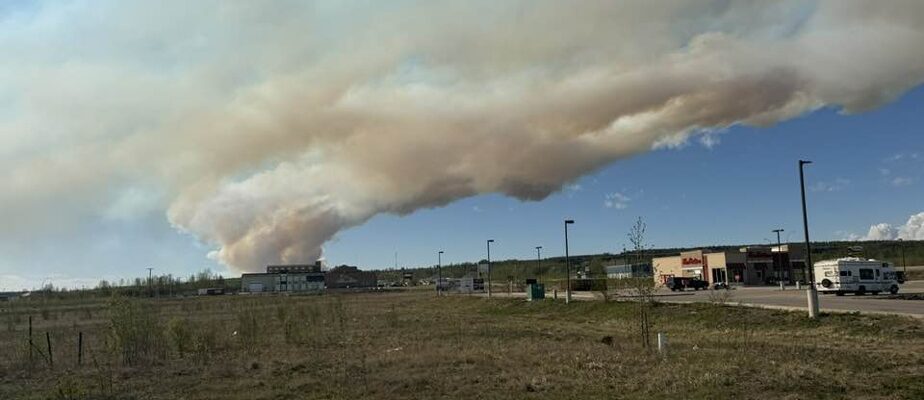(Fort Nelson) The northeastern British Columbia municipality, where thousands of people were evacuated due to a nearby wildfire, urged all remaining residents to leave immediately on Saturday , despite the improvement in weather conditions.
In a joint statement, the Northern Rockies Regional Municipality and Fort Nelson First Nation said people who remain behind despite evacuation orders should be aware that “emergency medical services are not available, not more than grocery stores or other amenities.”
“Public services may be impacted to support fire response efforts,” the statement said. Communication networks are precarious, which could impact the ability to reach residents to inform them of changing conditions. »
The statement comes as the Parker Lake Fire grew to nearly 17 square kilometers on Saturday, more than double the eight square kilometers reported hours earlier, with BC Wildfire Service maps showing the fire burning at just a few kilometers west of the Fort Nelson city limits.
Northern Health said in a statement that Fort Nelson General Hospital had been safely evacuated and was closed until further notice.
Health officials said patients at the hospital were transferred to facilities in Fort St. John and Dawson Creek.
Northern Rockies Regional Municipality Mayor Rob Fraser said most of the 3,500 residents of and around Fort Nelson, B.C., have been evacuated since the Parker Lake fire broke out Friday, but have the police knock on doors to make sure everyone gets out.
“We received virtually no opposition,” Mayor Fraser said of Fort Nelson residents’ reaction to the evacuation order. “I am still waiting to hear from the RCMP on how many people might remain in the community, but their initial discussions with me revealed it was very few. »
Evacuations were initiated for the Northern Rockies Regional Municipality and Fort Nelson First Nations Friday evening after the fire grew at 5:25 p.m. from an initial size of half a square kilometer to four square kilometers at 6:30 p.m., then continued to grow exponentially since.
Thick plumes of smoke
On social media, videos and photos from Fort Nelson residents showed thick plumes of smoke rising high into the sky with houses in the foreground, with some images revealing haze covering the area.
Bud Streeper, a Fort Nelson resident, posted a video update from the area Saturday, saying the winds that caused the Parker Lake Fire to grow exponentially Friday night had subsided overnight, reducing the fire activity around the city.
In an earlier video on Friday, Mr. Streeper explained how he prepared the buildings on his property as the fire grew nearby.
“So this whole property that you see here right now, you can see it’s soggy,” Mr. Streeper commented, pointing to a number of buildings as wildfire smoke was visible in the ‘background. “My house got a million gallons of water. Now we’ve moved to my old property…this thing takes the paint off these old buildings. This is the amount of water we dump there. »
Bud Streeper did not respond to requests for comment.
Mayor Fraser said the Parker Lake fire is one of three major wildfires near Fort Nelson, and what surprised residents was the “very dark” smoke rising from a distance close to the city, prompting the evacuation order.
The wildfire also blocked 9-1-1 and disrupted telecommunications in Yukon and northern British Columbia, with territorial authorities asking Whitehorse residents in need of help to go directly to the detachment local Royal Canadian Mounted Police (RCMP), fire stations or ambulances stationed throughout the city.
Mr Fraser said the fire was started by a tree toppled by high winds and falling on a power line.
Saturday’s update from the Northern Rockies Regional Municipality says the fire situation “remains volatile and evolving rapidly.” Authorities urged all remaining Fort Nelson residents to evacuate.
Residents were initially asked to flee to Fort St. John, about 380 kilometers to the southeast, on Friday, and the municipality’s update says those who can afford to travel further are being asked to travel further. 440 kilometers south to Prince George, British Columbia, where a reception center has been opened.
Mr Fraser said the pace of the fire has since slowed, with winds calming significantly and reducing the speed of the fire’s spread, but officials do not know when the evacuation order will be lifted.
The smoke spreads
Environment Canada says winds around Fort Nelson dropped to just two kilometers per hour on Saturday, after reaching 59 kilometers per hour on Wednesday.
High winds spread smoke from the fire across northeastern British Columbia and parts of Alberta on Saturday. Edmonton is under an air quality advisory, with danger levels assessed at more than 10 – or “very high risk” – expected throughout the day.
Meteorologist Heather Rombough says most of the smoke blanketing the city is from the B.C. wildfire, and residents should stay indoors or at least avoid any strenuous activity outside until ‘so that air quality improves.
Fort Nelson is located in the far northeast of British Columbia, approximately 1,600 kilometers from Vancouver.
The BC Wildfire Service says the Parker Lake fire was “highly visible” from Fort Nelson, with Mayor Fraser describing “very dark” smoke emerging from the fire Friday.
The regional municipality says evacuees traveling south are entitled to free fuel at the Buckinghorse River Lodge, 176 kilometers south of the city on the Alaska Highway, upon presentation of proof of residency in Fort Nelson.
Environment Canada is not forecasting rain in the region until Wednesday evening and is forecasting only a 60 per cent chance of showers that night and Thursday.
“There doesn’t seem to be much precipitation in this area over the next few days, unfortunately,” lamented Mme Rombough. By the start of next week there might be a little bit, but really nothing significant. »
